If there is one thing about SEO that most people do wrong it has got to be keyword research and implementation.
Even those who consider themselves experienced SEO pros are still doing keyword research using tools that don’t help to formulate complete content marketing strategies.
For example, I still see the primary keyword research being done in the Google Keyword Planner where your reference points for competition are “high, medium, or low. ”
These criteria are just not good enough to help you plan your content marketing strategy around, especially when you consider how relevant link building is to ranking.
Keyword research should identify opportunities for ranking with a strategy that is aligned with your website’s ability to rank for them.
Instead of targeting keywords or topics that have high volume, we need to target keywords and topics that we actually have a chance to rank for, making the best use of our time and SEO efforts.
So what if there were a way to guarantee that the content you write would actually rank with little or no link building efforts?
A way that purely relied on very systematic keyword research to find topics, sub-topics, and long-tail keywords that could be used to create resounding content marketing strategies and drive loads of traffic to the content you produced?
There is a way and I have aptly named it “Holy Grail SEO.”
We know the Holy Grail in Arthurian literature as a cup that has magical powers to provide happiness and infinite abundance. You, too, can do SEO that uses Holy Grail SEO tactics: target high volume, low competition keywords.
Keep reading to learn more about Holy Grail SEO and:
- The importance of low competition keywords and who should be going after them.
- Where to find high volume, low competition keywords.
- How to use keyword competition data together to create complete topics.
- How to generate happiness and abundance through your SEO and content.
We need to target keywords and topics that we actually have a chance to rank for
Are There Any High Volume, Low Competition Keywords Left?
If you’ve done SEO in a competitive industry you know how hard it can be to find topics to rank for that no one else has covered or that don’t require extensive amounts of link building.
You’re smart enough to know that the good old-fashioned “publish and pray” approach to ranking content just doesn’t work.
This is why SEO pros must leverage low competition keywords into their overall strategies so that they can get their sites to compete with the big boys.
Why Are Low Competition Keywords Important?
As SEO pros, if we are starting out with a client who is:
- A startup.
- Has a new website.
- Has little to no domain rating.
- In an industry that is super competitive.
- A combination of the above.
…then we are plagued to try and get results, fast.
Beyond the standard optimizations of the website, building our product or service pages, and trying to convince our clients they need a bigger budget for PPC or social promotion, we need to use our SEO expertise to make sure our clients stick around (or our bosses don’t fire us!).
While every client agrees that they understand SEO takes “six to eight” months, come month three with no sales generated they get squeamish.
And this is exactly why we need to use low competition keywords in our SEO and content marketing strategies. Low competition keywords are those that can rank with little to no link building and little to no domain authority.
Performed properly, merely publishing a blog based on a target of low competition keywords can provide (relatively) quick traffic and long-tail rankings.
Better yet, it provides us a solid foundation in which to write more competitive topics and go after more difficult, and often more volume-rich, topics.
Who Should Be Going After Low Competition Keywords vs. High Competition Keywords?
We’ve all reverse-engineered competitor websites in an effort to determine why they outrank ours.
We think, my topic is more in-depth, we have better graphics, better references, more social shares, and my blog is more-up-to-date, so why doesn’t it rank better?
More often than not this is because or competitors have a higher domain rating than us.
Sidenote: I say domain rating (DR), Ahrefs definition of the strength of a website’s backlink profile on a logarithmic scale of 0 to 100, with the latter being the strongest. Domain authority (DA) can also be used interchangeably.
Domain rating is why sites like Forbes can publish articles, do zero outreach, and generate a fraction of the backlinks as the rest of and still outrank us.
Sites with high domain rating are usually trusted resources and can publish content and rank for it while the rest of us have to work a lot harder at it.
Therefore, if you have a site you are trying to rank a blog for, chances are you’ll be going up against a media site or some very-well established juggernaut in your vertical.
This is also why you should be spending more of your time finding and developing content around high volume, low competition keywords, and topics.
Bottom line: high DR sites can go after high keyword difficulty topics and will usually rank for them; low DR sites, well, can’t.
So how do we define a high DR site?
High DR sites are measured generally, from the 0 to 100 scale, but can also be measured on the industry level which can also mean a high DR is industry-related.
For example, a site like Forbes is a general site that covers a broad range of topics and has a DR of 93. Forbes may or may not be going after keywords that you are.
In that case, you may not have to compete with general high DR sites like Forbes (you lucky dog).
If you don’t you are probably competing with other industry sites with a higher DR than yours, meaning you still have to be deliberate with your keyword research and topic creation.
Then again, there are industry sites that have huge DR.
For example, if you’re in the real estate space, there’s a good chance you’ll be going up against Realtor.com (DR90) or Zillow (DR91). In many cases, we’re up against industry sites and general sites for the same keywords/topics.
That’s OK though, we can still compete with these sites!
Where to Find High Volume, Low Competition Keywords
Now that we have an understanding of why low competition keywords are so important to so many of us, let’s take a look at three great ways I like to find high volume, low competition keywords.
Note: The definition of high volume keywords can be subjective. During your research you may find that you are targeting topics that have thousans of searches every month while other times you may be targeting those that have hundreds. Either way, keep in mind that the target keyword and topic may generate lots of long-tail traffic, which is why we will dive into using this research to piece together complete topics.
Method 1: Using Google SERPs to Reverse Engineer Results
Sometimes with keyword research, you can have a direct topic in mind to begin your research and other times you just visit competitors sites to find ideas. This first approach has to do with the former.
For example, my financial planning client Castle Wealth Management does a lot of wealth management for clients that are high net worth and thus wanted to create a blog on the topic of trusts.
So, before diving into a specific topic just because they wanted to cover it, as an SEO and content marketing agency, we push our clients to be more intentional about what we cover.
Being in the finance industry, I knew we’d be up against huge juggernauts like Forbes (DR 93), Nerd Wallet (DR 86), and Kiplinger (DR 84).
Taking to the Google SERPs and using the Ahrefs Chrome extension for its data on DR, Referring Domains, and Keywords a URL ranks for, we quickly found that generic posts on trusts such as “What is a trust?” were indeed dominated by the likes of huge brands like Bankrate.
Further, the topic had a Keyword Difficulty (KD) of 29, the top post had 40 referring domains (RD), and the top site, a domain rating of 89. Since the goal is to generally get within the top three rankings, we decided to move on from this topic.
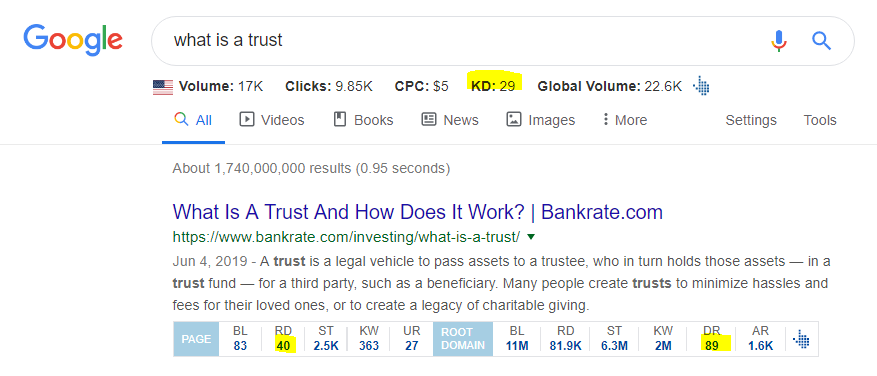
After a handful of searches we discovered the long-tail topic “why would you put your house in a trust?” was opportune for the picking. Below we see this exact keyword gets 200 searches per month.
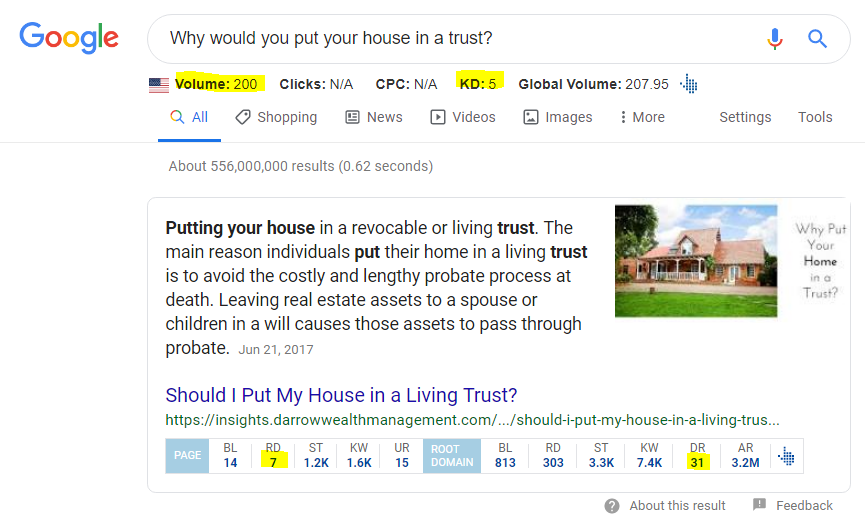
Now, 200 is not really a pot of gold by any means in terms of volume, but you’ll see that sometimes you have to look beyond the primary keyword volume and keep an eye on long-tail traffic.
When researching this topic we found that a site (Darrow Wealth Management) with a similar DR (31 to our client’s 27) was ranking #1.
Further, their post on the topic only had 7 referring domains and was ranking in the top 100 for over 1,600 keywords, many of which were in the top 10. Long-tail goldmine? Perhaps…
Inside Ahrefs, you are able to take a look at all the keywords, their volume, their keyword difficulty, position, and more to get an idea of how your competition stacks up.
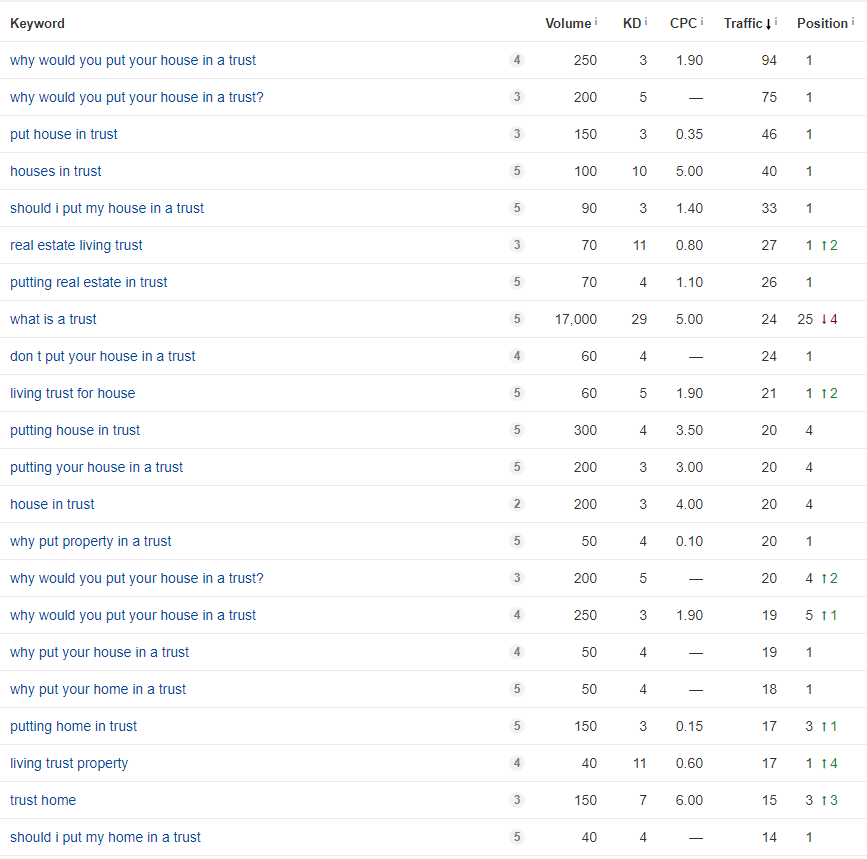
As you can see, Darrow Wealth Management ranks within the top 5 for a ton of searches related to “why would you put your house in a trust.”
With this knowledge in the bank, we can now take an even closer look at our primary keyword to see what kind of backlink profile we need to build if we want to rank on Page 1.

According to Ahrefs, the keyword difficulty of 3 means we’ll need links from about 4 websites to rank in the top 10 for this keyword. I’ve found this metric to not always be true as we were able to rank #2 for this search with only one backlink.
Fast forward about three months post blog production, and you’ll see our high volume, low competition strategy worked.
Check out how our client’s site now ranks for related keywords:
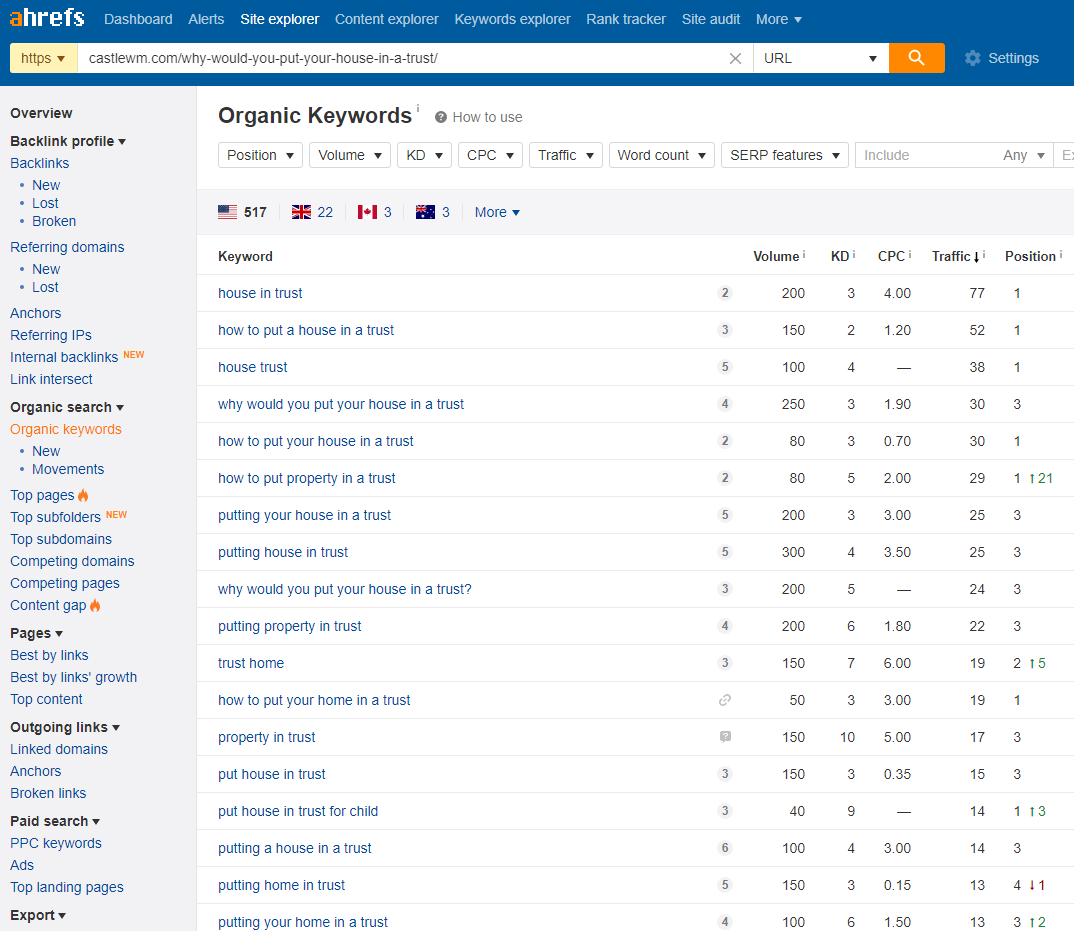
While the site is not in Position 1 for the target keyword, we only actively built one backlink to the page and have benefited tremendously from our strategy. The blog ranks for a ton of long-tail searches, over 500, and grew organically over the next eight months:

This is all but one strategy to find keywords and topics to write about. You can also let software do all the work for you.
Oh, and if you’re saying “well there really isn’t any competition for that at all what a joke this strategy is” just check out the high DR sites that are also going for this keyword that our strategy has beat out.
Our strategy put our client in the second spot and beat out sites like SFGate (DR90), CNN (DR92), and Pocket Sense (DR70) all with one referring domain.

Method 2: Using Keyword Software to Target Specific Topics
Another method that is really good for finding high volume, low competition keywords is by using software to help you filter through data. Using the Ahrefs Content explorer, we can utilize some great filters to find low hanging fruit content.
Start with a generic keyword search. For example, “garment bag.”

Now, you’ll see a bunch of pages in the index that mention your target keyword. In this case, there are over 14,000 pages in the index so I want to filter them out.
There are a lot of considerations and filters that can be applied, but part of the fun is playing around with the tool.
First and foremost, however, you’ll want to filter out any pages that are not ranking for anything. I’ll set the organic traffic filter to “From: 500” for starters so we only see pages that rank for over 500 keywords. You can be more aggressive or less aggressive depending on the results.
In this case, the filter leaves me with 173 pages which is pretty good considering where it started.
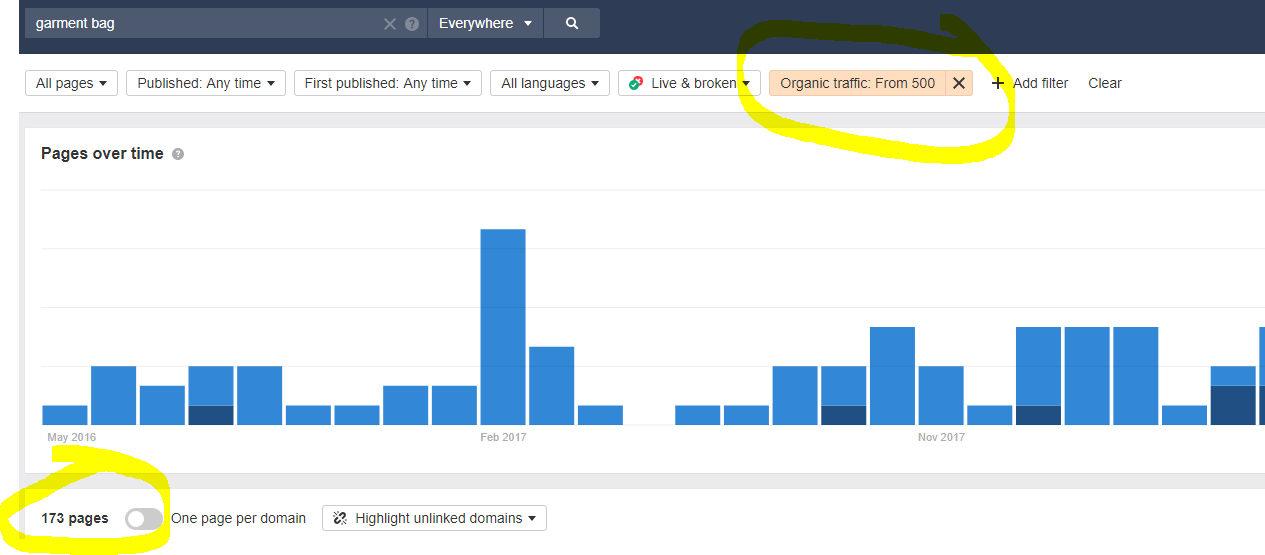
Because I want sites that have a low, or relatively modest domain rating, I’ll also filter sites that are above a DR30.
I do this because I will know my chances of finding a topic that a low DR site ranks for means my site can probably do the same.
This is not always the case, however. Sometimes high DR sites can be goldmines for low competition, high volume topics. But in this example, we’ll stick to low DR sites that have low competition, high traffic blogs we can steal from.
With our new filter set, we now see there are 10 pages to evaluate based on our “garment bags” topic:

Now, all we have to do is open up the organic traffic tabs on the various sites to see if we can find some keyword opportunities that fit the Holy Grail bill.

Voila! Holy Grail SEO goldmine!
The first blog has a bunch of topics and the metrics tell me it is a good option to cover.
First off, the referring domains to the site are at one, the site has almost 1,200 keywords in the index, the keywords I see showing up are all really low keyword difficulty, and the volume of the keywords collectively and of a few isolated ones are great (ex. “Garment bag carry on” 1,600 volume, KD1; “garment duffel bag” 500 volume, KD1).
I can repeat the same process of investigation on the other sites that showed up in the list and jot down the other keywords I want to hit in my blog.
This approach is great, but the other approach can often find topics even faster. And that is using competitors to find high volume, low competition Holy Grail content.
Method 3: Looking at Competitors to Find HV/LCK Keywords
One of my favorite Holy Grail SEO techniques is to mine competitors sites for keywords and blog topics.
Even sites with high DR can be goldmines for high volume, low competition keywords.
And as we’ve seen in the Castle Wealth Management example, you can beat out sites with high DR with a well-written low competition keyword target.
For example, let’s stick to our finance example. This is an extremely competitive industry with competition in niche sites, industry sites, and general news sites like CNN.
I’ll visit one of the most popular financial advice sites, NerdWallet, to see if I can’t find some high volume topics to cover.
I bring the site into Ahrefs Site Explorer to dissect it. Inside this tool, we can sort topics by the Top pages – pages that the software tells me ranks for a ton of keywords – as well as set a filter for Keyword Difficulty.
In this case, I set the KD filter to 10 (although you could probably go a lot lower to see what you find).

Take a look at the filtered settings to see if there are contextually relevant topics that you think your audience would enjoy.
For example, let’s say I run a general financial advice site, right off the bat I see “how to fill out a money order” and “best time to buy a tv” as some potential targets.
To investigate further, I open the Organic Keyword report for each and look at the Volume and Keyword Difficulty of the results.
The Position is also worth noting as well as this shows that solid rankings here can likely be duplicated with a similar blog.


Looking at these two side by side, we see that the “Best time to buy a TV” topic has a slightly higher keyword difficulty. Most of the keywords sit around 8 while the “How to fill out a money order” sits around 6.
Further, there seems to be a lot more keyword volume for the money order primary keyword – 23,000 versus 11,000.
Ultimately you may decide to cover both topics but if you were to choose one over the other, you’d want to go with the easier of the two.
Digging a little further still, you’ll want to see how many backlinks you may need for each. You’ll need about 7 and 9 links, for the money order and TV blogs, respectively.


Putting Your Keyword Competition Data Together to Create Complete Topics
I’ll be the first to admit that good keyword research is only the beginning. You’ll still need to implement it properly if you want the research to help drive traffic.
Here are some more tips on bringing the grail home.
Keyword Research Still Needs to Be Complemented with Great Writing
Yes, good keyword research does not mean you can get away with writing crappy blogs. This may be an obvious point, but let’s get that out of the way. Here are some resources to help you with that:
- How to Write for Users & Search Engines in 2019
- How to Write Content for Each Stage of Your Sales Funnel
- How to Write Blogs That Win: Your Essential Guide
Beyond good writing, one tip I have for you is to be exhaustive with a topic. Being exhaustive with a topic is part research and part logic and I find often involves a lot of keyword rich sub-topics.
For example, let’s take a look at our keyword data for the aforementioned “garment bags” research:

From here, we know we have keyword data and volume but that alone doesn’t make the blog come to life.
What we want to do is then use some logic to determine what would make good talking points in our post while also being intentional about the keyword opportunities. So, let’s say you decide on a general post of “15 Best Garment Bags of 2019” as your topic.
You can then use this keyword data to break down some good sub-topics that obviously have some volume behind them.
Note: For the sub-topic portion I don’t always focus on topics with low keyword difficulty. This can be helpful to do but if a sub-topic is appropriate for your post, don’t be afraid to cover it if you find it is a competitive keyword.
Perhaps in this post, I’ll have my writer cover the following as sub-topics:
- Best roll up garment bags
- Best carry on garment bags
- Best garment bags with wheels
- Garment bag carry on rules
- When to get a tri fold garment bag
In this case, my keyword research is dictating my sub-topics, making it a win for the overall topic but also for the implementation of my keyword research.
Also, check out Google SERPs for even more ideas that Google is telling you people are also interested in within the “People also ask” and “Searches related to” sections in the SERPs.
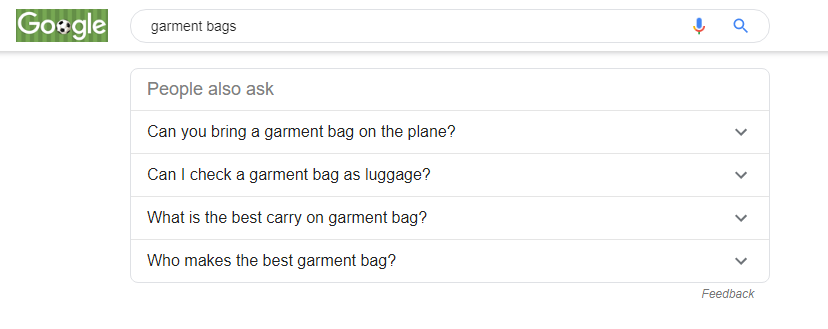

The Quest for Holy Grail SEO Never Ends
The ability to drive traffic to sites that are high volume and low competition is very real. It is a great strategy for startups, new websites, sites with little to no domain rating, and sites that just want to build more traffic.
The research is actually quite simple and with a little practice can be implemented in just a few minutes. While we never rule out link building as a deliverable, it is nice to show gains in traffic without having to spend a bunch of time and resources building links.
Give Holy Grail SEO a try for yourself and I promise, done right, it will work wonders for your content marketing strategy.
Get a Consultation on Your
Site's Holy Grail SEO and Content Marketing Opportunities.
The opinions expressed in this article are the sponsor's own.



